7 Yoga Poses to Relieve Stress and Anxiety

To combat stress and anxiety, perhaps you indulge in a glass of wine after a long day or try to catch up with a friend on the phone. My coping strategy has quickly become yoga, and since I started practicing late last year, I can attest to the fact that it eases stress and calms my mind while also helping to work and relax my physical body. I’m not alone in this experience either—experts say certain yoga poses are ideal to combat these feelings.
“Yoga is a powerful tool for managing stress and anxiety because it brings the mind and body into harmony. By focusing on your breath and moving through poses with intention, you create a space where you can let go of worries (at least temporarily) and ground yourself in the present moment,” L’Oreal Thompson Payton, certified yoga and meditation teacher, author, and speaker, tells Best Life.
She continues, “Yoga encourages mindfulness, which helps you become more aware of your thoughts and feelings without judgment. This practice of awareness can reduce the intensity of anxiety and stress, offering a sense of calm and clarity wherever you are.”
But while any kind of yoga practice may help put your mind at ease—whether you prefer a hot power flow or a slower Yin Yoga session—introducing a few specific poses can have the same effect. Read on for the seven best yoga poses to relieve stress and anxiety.
RELATED: 7 Best Yoga Workouts for Weight Loss, Fitness Experts Say.
1
Child’s pose (Balasana)
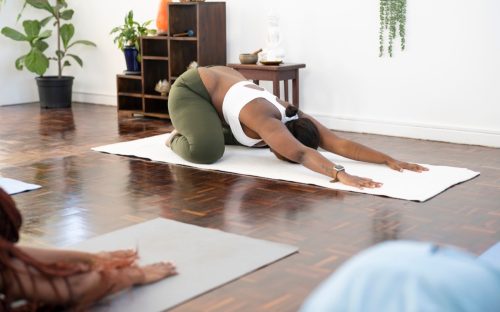
First up is a familiar name: child’s pose. This restorative posture can help “calm the mind and relieve tension in the body,” Thompson Payton explains. It’s a favorite of hers and one of my go-to’s as well.
To get into child’s pose, start on your knees on your mat. You then fold forward over your knees and rest your forehead on the mat. Thompson Payton notes that a blanket or yoga blocks can be helpful if your forehead can’t quite reach the ground. By doing so, you stimulate the parasympathetic nervous system, which promotes relaxation and reduces stress.
You can do this pose with closed knees and arms lying behind you or with your knees spread wider and your hands reaching forward.
Personal Tip: I prefer a wide-knee child’s pose during my practice, as it’s more comfortable for my hip flexors! I also like to alternate my reach to both corners at the top of my mat for a side-body stretch.
2
Camel pose (Ustrasana)
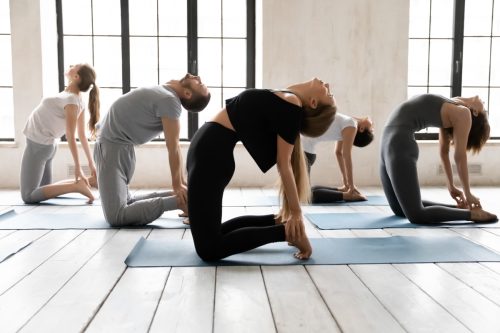
Camel pose is another posture you can perform close to the ground to help relieve stress.
“[It] helps stretch the front part of the body by releasing stuck energy and old emotions stuck in your hips,” says Mimi Ghandour, founder of Mimi Yoga. “It will help you calm the mind and think more clearly.”
To take camel pose, start by kneeling with your legs hip-distance apart, then lift your chest, arch your back, and reach for your ankles.
“As a backbend, this pose is great for opening your chest and releasing pent-up emotions, stress, or tension, especially in your chest or back,” says Brandt Passalacqua, certified yoga therapist and founder, director, and lead teacher of Breathing Deeply Yoga Therapy.
Personal Tip: I have a bit of difficulty reaching my ankles when the tops of my feet are flat on the mat. To modify this pose, I tuck my toes to make my ankles more accessible or place my hands on my lower back. This is also a great opportunity to incorporate blocks!
RELATED: Hot Yoga Can Reduce Depression by 50%, Study Says—The Easy Way to Start.
3
Legs Up the Wall (Viparita Karani)
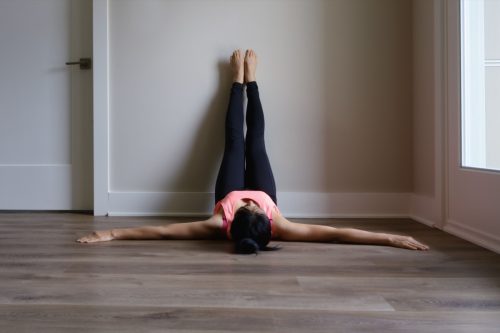
You can also relieve stress and anxiety by doing legs up the wall, which involves doing exactly what it sounds like.
“Elevating your legs against a wall is incredibly soothing (I just did this one the other night after putting my daughter to bed!),” Payton Thompson shares. “This pose helps to improve circulation, calm the nervous system, and reduce anxiety. It also allows your mind to quiet down and your body to release accumulated stress.”
Personal Tip: I often do legs up the wall in a yoga class, where wall space isn’t always accessible. If you’re ever in a similar situation, place a block under your hips and lift your legs that way. You can reach for your toes or T-out your arms—whatever feels more comfortable that day.
4
Cat-Cow pose (Marjaryasana-Bitilasana)
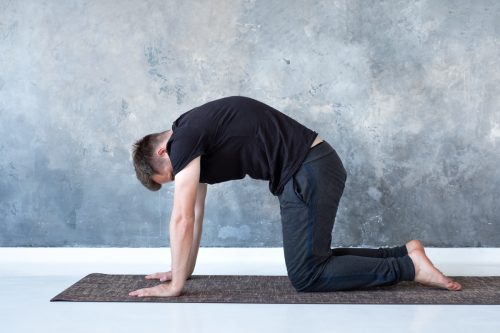
You might be familiar with cat-cow pose, which is often introduced in the beginning portion of a yoga workout video or class. An instructor will cue fluid movements between cat pose and cow pose, where your back is rounded and arched, respectively.
“The cat-cow poses are very effective in releasing stress because of their rhythmic breathing patterns,” Ghandour says. “Practicing these poses together will help you stretch the muscles on the chest, abdomen, spinal muscles, and back side of the body. The regular slow breathing movements help calm the body down.”
Personal Tip: This is a pose I’ll often do if I feel stressed during the work day. It’s a great option to relieve some of the tension in the neck and back. Also try turning your fingers inwards and lean back on your heels for a nice wrist stretch.
RELATED: 7 Ways Breathwork Can Ease Stress and Improve Your Health.
5
Seated Forward Bend (Paschimottanasana)

Seated forward bend is a formal yoga pose (even if it feels like a basic hamstring stretch)—and it can do a lot more for stress than you realize.
“Forward bends are calming and introspective, helping to soothe the mind and nervous system,” Thompson Payton explains. “This pose stretches the back and hamstrings, releasing physical tension and encouraging a state of relaxation.”
Passalacqua also notes that this pose can “encourage feelings of comfort, safety, and relaxation.”
Passalacqua instructs you to get into this pose by sitting with your legs straight out in front of you, leaning over them, and grasping your feet or your legs with your hands.
Personal Tip: If you have tight hamstrings like me, this posture can be deceivingly hard. While it’s easy to be down on yourself for not being as flexible, this posture is easily modified. Try bending your knees to make your feet more accessible, or simply reach as far as you can without arching your back. In general, I prefer standing forward bend/fold, which is essentially the same pose aided more so by gravity. Ghandour cites standing forward bend as another that’s helpful for stress and anxiety relief.
6
Downward-Facing Dog (Adho Mukha Svanasana)

Another stress-relieving pose that’s great for beginners or seasoned yogis is downward-facing dog.
“Downward-facing dog is ideal for relieving stress in the spine, lengthening the hamstrings and calves, and stimulating blood circulation in the body,” Ghandour says. “In this pose, the heart is present over the head, and the blood flow is supported by the action of gravity.”
Personal Tip: I love a good downward-dog stretch after a run or if my body is feeling particularly tight after a day sitting at my desk. It’s another posture where you might feel like you’re not doing it “right” if your heels aren’t touching the mat, but the more important part is to get your hips high to achieve that A-frame look! If you’re heels don’t touch (like mine) that’s A-okay.
RELATED: 9 Best Pilates Exercises for Weight Loss, Fitness Experts Say.
7
Corpse pose (Savasana)
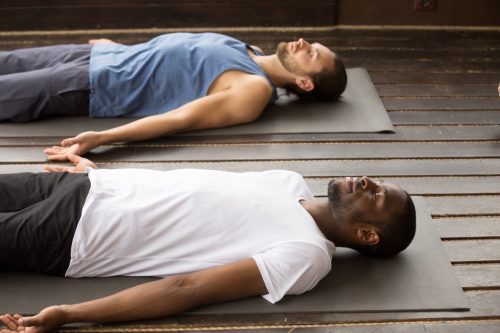
Corpse pose is probably the most relaxing pose, which is why it’s often done as the last part of a yoga practice.
“Lying still on your back allows your body to absorb the benefits of your practice, while your mind can enter a state of deep rest, reducing stress and anxiety significantly,” Thompson Payton says. “Sometimes you may even fall asleep in this pose, and that’s okay! I like to linger in this pose during a restorative practice or right before bed.”
Personal Tip: Before I started practicing yoga, the idea of lying motionless on my back with just my thoughts was more anxiety-inducing. But now, I can say I genuinely look forward to Savasana. If you struggle with a wandering mind in corpse pose, I find it’s helpful to picture yourself in your happy place. For me, that’s a flower-filled valley overlooking mountains. It sounds silly, but it does help!